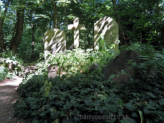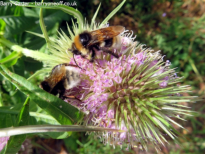





Docklands and the Thames,
Victoria Park to Paternoster
Square. Take a nostalgic
trip back to the East End in
the 1950’s or a stroll around
the Square Mile of the City
of London. It’s all here at
barryoneoff.co.uk
Copyright 2002 - 2024 ©Barry Carter. All rights reserved
TOWER HAMLETS CEMETERY PARK
A Brief History of The
Park
I am ashamed to admit it, but after living in the East End for over 70 years I honestly had no idea this place existed until 2019, when I joined a walking group just before the Corona virus lockdown the following year! It was opened and consecrated by the Bishop of London, on Saturday 4th. September 1841 as "The City of London and Tower Hamlets Cemetery". The first burial took place later that same afternoon. It was one of the Victorian "Magnificent Seven" cemeteries opened between 1832 and 1841, the others were: Highgate, Nunhead, West Norwood, Kensal Green, Brompton and Abney Park. The cemetery had 11 company directors from various businesses to administrate. Many East enders were buried here. A large percentage were buried in public graves, for people not being able to afford a plot of their own. These graves were unmarked and could contain many unrelated bodies. An estimated 350,000 people are buried here. Due to bad management the cemetery deteriorated over the years and was reported to be in a "neglected state". It also suffered bomb damage several times during the war when bombers were targeting the City of London. The chapels were hit and many gravestones were damaged. The last burials in what had now become known by locals as Bow Cemetery took place in 1966, when the cemetery was closed by the Greater London Council after a compulsory purchase order. They had intended to turn it into a public open space but after starting to clear the graves local protests and lack of funds prevented the conversion. It was once again taken over in 1986 by Tower Hamlets Council. After years of neglect and in a state of disrepair, a group of locals formed The Friends of Tower Hamlets Cemetery Park, an independent charity, in 1990 and in 2000 it was officially declared a nature reserve. The park now has a few full time staff and many volunteers. and there is plenty of wildlife as well as visitors using it.Scrapyard Meadow
Scrapyard Meadow is another area, adjacent to the Cemetery Park, that the FoTHCP look after. They have turned an unused piece of land next to the railway arches into another local nature reserve. Chalk mounds make a home for certain types of plants while preventing unwanted ones taking root. In 2013 a chalk labyrinth was added. The meadow is home to a variety of species of plants and insects, including Britain’s smallest butterfly, the Small Blue. Depending on the weather and the time of day the amateur entomologist or botanist is bound to find something of interest if you look hard enough. Scrapyard photos >>Ackroyd Drive Green
Link
Cross over Bow Common Lane from Scrapyard Meadow, turn right under the railway arch and little way down you will find another local nature park tended by Friends of Tower Hamlets Cemetery Park, Ackroyd Drive. It is made up of four separate plots in a line by the side of the railway arches. These are: Cowslip Meadow, Blackberry Meadow, Pear tree Meadow and Primrose Meadow. Unfortunately the line is broken by an unrelated allotment but you can still walk the whole of them. The arches have been decorated by artists depicting endangered species of animals. Hopefully their work will remain without talentless little scrotes spraying their meaningless tags all over them! Just like Scrapyard meadow, it’s a haven for wildlife and insects. Places like this are needed in towns and cities. They encourage the wildlife and insects that are important to us all. If the bees go, the plants go, followed by the animals that eat the plants, followed by us! Think about it. More photos >>An Urban Nature
Reserve
At the time of this update (2022) it has been 56 years since the last burial and closure. For many of those years it was neglected and left for nature to take it’s course. This can be upsetting for some people. Trees growing up between the headstones, some being toppled by their roots. Others sunk into the soft ground and then the inevitable acts of vandalism. On the good side, this has created a peaceful 27 acre haven for wildlife and plants in the centre of an urban area. After years of hard work, the Friends of Tower Hamlets Cemetery Park, working with the local council and LBTH Parks department, have managed to bring order from this chaos. Selective tree felling, the creation of open spaces and wildflower meadows, make a pleasant place to visit. The staff and volunteers constantly work to improve it For the youngsters there is a forest school, guided walks and nature talks along with many other workshops, walks and organised events for both adults and children. Main paths have been created centrally and around the perimeter with many smaller walkways leading off into the vegetation. You’ll find many types of flowers and plants, insects, butterflies and birds, depending on the time of year. A very relaxing place indeed. There are two war memorials in the park. A large on at the entrance in Southern Grove commemorating two world wars, and a smaller one along one of the paths dedicated to the 190 local people who were killed in the blitz of World War II. A newer monument (top of this column) was erected in 2016 to mark the grave of three of Doctor Thomas Barnardo’s sons. It is also a reminder that over 500 Barnardo children are buried in various places in the cemetery park. He had many homes for poor children in the East End and also founded the Ragged School Museum. Finally, the park also has it’s “artists in residence”, so you may come across ears on trees or plaster fungi on logs while on your walk. More Cemetery Park photos >>





























